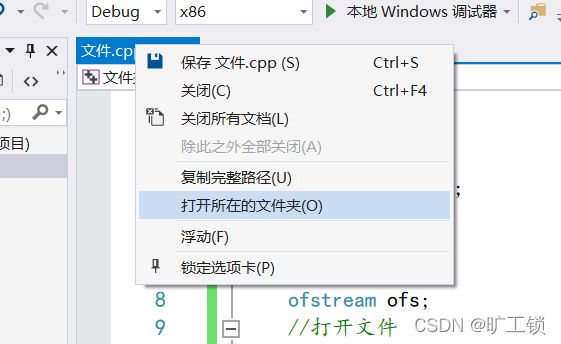c++文件
写文件:
文件的作用:存储数据
头文件:#include
ftell() 函数用于得到文件位置指针当前位置相对于文件首的偏移字节数;
fseek()函数用于设置文件指针的位置;
rewind()函数用于将文件内部的位置指针重新指向一个流(数据流/文件)的开头;
ferror()函数可以用于检查调用输入输出函数时出现的错误。
文件分类:
1.文本文件: 以ASCLL码存储在电脑上
2.二进制文件:以二进制数存储在电脑上
操作:
| ofstream | 写操作 |
| ifstream | 读操作 |
| fstream | 读写操作 |
打开方式:
使用时可以配合使用: ios::in | ios::out
| ios::in | 读文件而打开 |
| ios::out | 写文件而打开 |
| ios::ate | 初始位置:文件尾 |
| ios::app | 追加的方式写文件 |
| ios::trunc | 如果文件存在先删除再创建 |
| ios::binary | 二进制方式 |
写文件:
1.头文件: #include
2.创建流对象: ofstream ofs;
3.打开文件: ofs.open("文件路径",打开方式);
4.写数据: ofs<<"写入数据";
5.关闭文件: ofs.close();
#include
//头文件
#include
using namespace std;
int main()
{
//创建流对象
ofstream ofs;
//打开文件
//写入操作
ofs.open("text.txt", ios::out);
//写内容
ofs << "故辞";
//关闭文件
ofs.close();
system("pause");
return 0;
} 运行结果:
右键cpp文件,打开文件夹
系统会把文件创建到 项目文件夹中
打开text文件
读文件:
1.头文件: #include
2.创建流对象:ifstream ifs;
3.打开文件并判断文件是否打开成功
ifs.is_open();
ifs.open("文件路径",打开方式)
读数据
第一种:
char c[50] = { 0 };
//读入数据
while (ifs >> c)
{
cout << c << endl;
}第二种:
char c1[50] = { 0 };
//一行一行添加
while (ifs.getline(c1,sizeof(c1)))
{
cout << c1 << endl;
}第三种:
添加头文件:#include
string s;
while (getline(ifs,s))
{
cout << s << endl;
}第四种方式:
char a;
while ((a = ifs.get()) != EOF)//EOF end of file
{
cout << a;
}5.关闭文件:ifs.close();
void text()
{
//创建流对象
ifstream ifs;
ifs.open("text.txt", ios::in);
if (!ifs.is_open())
{
cout << "文件打开失败" << endl;
return;
}
//读数据
//第一种
char c[50] = { 0 };
//读入数据
while (ifs >> c)
{
cout << c << endl;
}
//第二种
char c1[50] = { 0 };
//一行一行添加
while (ifs.getline(c1,sizeof(c1)))
{
cout << c1 << endl;
}
//第三种
string s;
while (getline(ifs,s))
{
cout << s << endl;
}
//第四种方式
char a;
while ((a = ifs.get()) != EOF)//EOF end of file
{
cout << a;
}
//关闭文件
ifs.close();
}二进制文件:
打开方式:ios::blnary
写文件:
write函数所在的头文件为
write有两种用法。一种是:
ssize_twrite(int handle, void *buf, int nbyte);
handle 是文件描述符;
buf是指定的缓冲区,即指针,指向一段内存单元;
nbyte是要写入文件指定的字节数;返回值:写入文档的字节数(成功);-1(出错)
write函数把buf中nbyte写入文件描述符handle所指的文档,成功时返回写的字节数,错误时返回-1.
另一种是:write(const char* str,int n)
str是字符指针或字符数组,用来存放一个字符串。n是int型数,它用来表示输出显示字符串中字符的个数。
write("string",strlen("string");表示输出字符串常量
利用函数流对象:ostream&write(const char *buffer,int elem)
buffer 是指向内存中的存储空间
elem 是读取的字节数
class person
{
public:
person()
{}
person(string name, int age)
{
Name = name;
Age = age;
}
string Name;
int Age;
}; person p("故辞", 5);
//创建流对象
ofstream ofs;
//打开文件
ofs.open("perosn.txt", ios::out | ios::binary);
//写入文件
ofs.write((const char*)&p, sizeof(person));
//关闭文件
ofs.close();运行结果:
读文件:
istream& read( char* buffer,int elem)
buffer:指的是指向内存中的一段内存
elem:读写的字节数
void text1()
{
//创建流对象
ifstream ifs;
//打开文件
ifs.open("perosn.txt", ios::in | ios::binary);
//是否打开成功
if (!ifs.is_open())
{
cout << "打开失败" << endl;
return;
}
//读文件
person p1;
ifs.read((char*)&p1, sizeof(person));
cout << p1.Name << " " << p1.Age;
}运行结果:
C++移动和获取文件读写指针(seekp、seekg、tellg、tellp)
| seekg (int x, mode) | 设置文件读指针的位置 |
| seekp(int x , mode) | 设置文件写指针的位置 |
| tellg() | 返回文件读指针的位置 |
| tellp () | 返回文件写指针的位置 |
- x 表示起始的位置
- mode指的是文件读写指针的设置模式
| ios::beg | 从文件开始向后的 x 字节处 (x只能为非负数) |
| ios::cur | x 为负数则表示从当前位置朝文件开头方向移动 x字节,为正数则表示从当前位置朝文件尾部移动 x字节,为 0 则不移动 |
| ios::end | 让文件指向从文件结尾往前的 |x|(x 的绝对值)字节处。在此情况下,offset 只能是 0 或者负数。 |
参考文献:
C++移动和获取文件读写指针(seekp、seekg、tellg、tellp) (biancheng.net)





